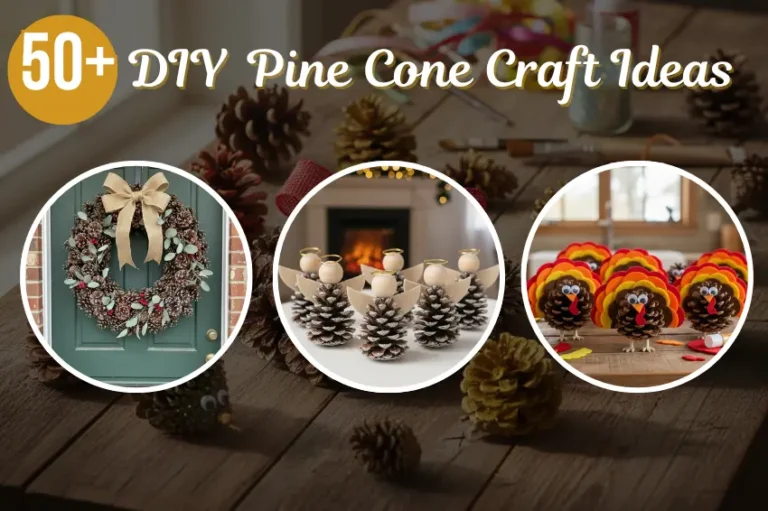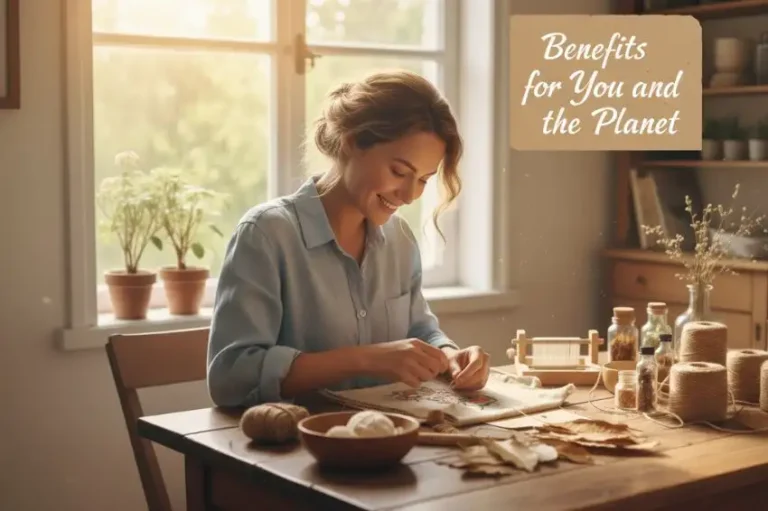Complete Guide to Eco-Friendly Crafts: Creative and Sustainable Ideas
Remember when crafting meant endless trips to the craft store, piles of plastic packaging, and projects that ended up in landfills after their moment of glory? Yeah, those days are fading fast. Today’s creative minds are discovering something remarkable: the most beautiful, meaningful crafts often come from the simplest, most sustainable sources. Welcome to the world of eco-friendly crafts, where your creativity meets environmental responsibility in the most satisfying way possible.
Think of sustainable crafting as giving materials a second chance at life. That glass jar from last night’s pasta sauce? It’s not trash—it’s a future candle holder waiting to happen. Those fabric scraps collecting dust in your closet? They’re tomorrow’s patchwork masterpiece. We’re not just making things here; we’re reimagining how creativity can exist in harmony with our planet.
What Are Eco-Friendly Crafts?
Let’s start with the basics. Eco-friendly crafts are creative projects that minimize environmental impact while maximizing your artistic expression. These aren’t your grandmother’s crafts (though she probably knew more about sustainability than we gave her credit for). Modern eco crafts combine traditional techniques with contemporary awareness about our planet’s wellbeing.
At their heart, these projects prioritize three things: using materials that don’t harm the environment, reducing waste wherever possible, and creating items that last. You’re choosing natural fibers over synthetic ones, plant-based dyes over chemical alternatives, and salvaged materials over brand-new purchases. It’s like being a creative detective, finding treasure in what others might overlook.
The beauty here is that eco-friendly doesn’t mean boring or limiting. Actually, working within these parameters often sparks more creativity than unlimited resources ever could. When you can’t just run to the store for supplies, you start seeing potential everywhere. That’s when the magic happens.
Why Sustainable Crafts Matter More Than Ever
Here’s something worth considering: the global craft supply industry generates millions of tons of waste annually. Glitter alone (yes, that sparkly villain) contributes microplastics that end up in our oceans. But before you feel guilty about every craft project you’ve ever made, remember this—awareness is the first step toward change.
How do eco-friendly crafts help the environment? They reduce demand for new raw materials, keep items out of landfills through upcycling, eliminate harmful chemicals from your creative process, and inspire others to think differently about consumption. Every recycled paper notebook you craft, every naturally dyed scarf you create, sends ripples outward. Your neighbor sees it, gets curious, and suddenly two people are crafting sustainably instead of one.
The carbon footprint of handmade eco crafts is significantly lower than mass-produced alternatives. When you make something yourself using local, natural, or upcycled materials, you’re bypassing the entire manufacturing and shipping chain. That’s a win for you and the planet.
Getting Started: Essential Sustainable Craft Supplies
Where can I buy sustainable craft supplies? Great question. While you can find eco-friendly materials online from specialized retailers offering organic cotton fabric, bamboo utility products, and natural dye kits, the best supplies might already be in your home. Check your recycling bin, rummage through old clothes, or explore your yard for natural materials.
Here’s what belongs in your sustainable craft stash:
Natural Materials: Bamboo, jute, hemp, organic cotton fabric, palm leaves, and sustainably sourced wood form the foundation of countless projects. These materials biodegrade naturally and often come from renewable sources. Bamboo grows incredibly fast without pesticides, making it a superstar in the eco-craft world. Of course, bamboo is just the beginning! If you’re looking for more inspiration straight from nature, We’ve compiled a list of to get your creativity flowing.
Upcycled Treasures: Glass jars, cardboard boxes, fabric scraps, old buttons, newspaper, magazine pages, and worn-out denim are goldmines for creative reuse. Before tossing anything, ask yourself: could this become something beautiful?
Eco-Friendly Adhesives and Tools: Biodegradable craft glue, non-toxic eco-friendly paints made from natural ingredients, reusable crafting supplies, and handmade paper from recycled fibers keep your projects genuinely green from start to finish.
| Material Type | Examples | Best For | Environmental Benefit |
|---|---|---|---|
| Natural Fibers | Jute, hemp, organic cotton | Weaving, sewing, macramé | Biodegradable, renewable |
| Recycled Paper | Newspapers, cardboard, magazines | Paper crafts, collages | Reduces landfill waste |
| Glass & Metal | Jars, cans, bottles | Storage, décor, planters | Infinitely recyclable |
| Fabric Scraps | Old clothes, linens | Quilting, rag rugs, stuffing | Extends textile life |
| Natural Elements | Leaves, twigs, stones, flowers | Décor, jewelry, art | Zero processing needed |
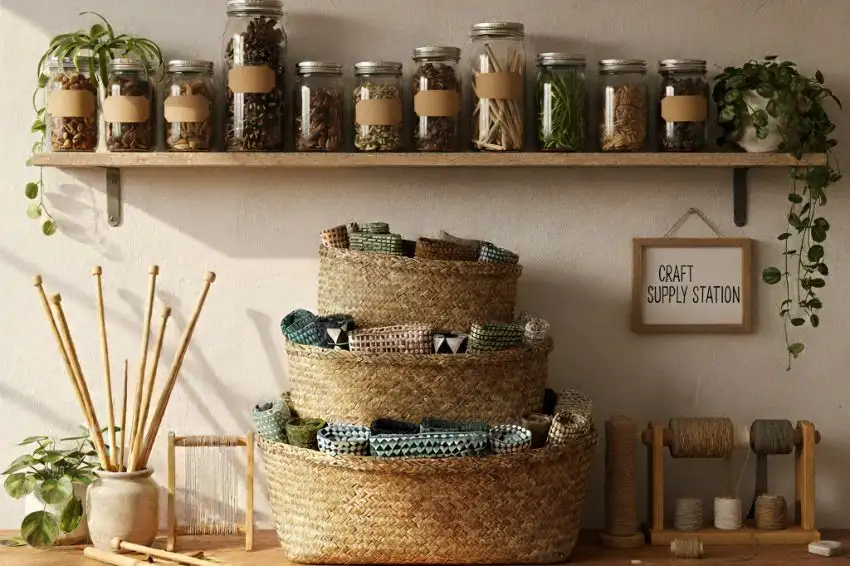
Simple Eco-Friendly Craft Ideas for Beginners
What are some simple eco-friendly craft ideas for beginners? Let’s dive into projects that don’t require expert skills or fancy equipment—just enthusiasm and a willingness to experiment.
DIY Eco Crafts for Beginners: Paper Projects
Eco-friendly paper crafts are perfect entry points into sustainable creativity. Start with plantable seed paper kits—you mix recycled paper pulp with flower seeds, press it flat, and let it dry. The result? Greeting cards or gift tags that recipients can plant in their gardens. It’s the gift that literally keeps on giving.
Another accessible project involves creating journals from recycled paper kits. You’re not just making a notebook; you’re giving waste paper a second life. The slightly imperfect texture of handmade recycled paper adds character that pristine store-bought notebooks never achieve.
Upcycled Crafts That Transform Trash
Glass jar lanterns might sound basic, but they’re stunning. Clean jars, wrap them with natural fiber yarn or jute, add a tea light, and you’ve got ambiance for days. These handmade eco-friendly home décor pieces make thoughtful eco-friendly gift ideas handmade with care.
Denim pocket organizers use old jeans destined for the trash. Cut out the pockets, arrange them on a piece of reclaimed wood or sturdy cardboard, and suddenly you have wall storage that’s both functional and conversation-starting. This is recycled fabric crafts at its finest—practical, personal, and planet-friendly.
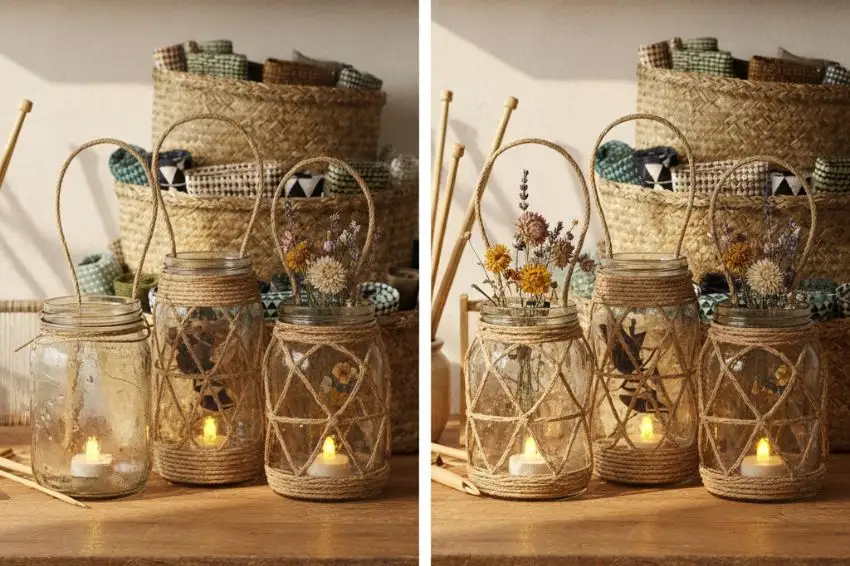
Natural Dye Crafts: Color from Your Kitchen
Natural dye crafts open up a whole rainbow of possibilities using ingredients you might already have. Turmeric creates gorgeous golden yellows, avocado pits (yes, really) produce soft pinks, and red cabbage yields anything from blue to purple depending on your water’s pH. It’s like high school chemistry, but the results are wearable.
For your first natural dyeing adventure, grab some sustainable fabric dyeing kits or simply use white organic cotton fabric and kitchen ingredients. Simmer your dye material in water, strain it, add your fabric, and watch the transformation. The colors are softer and more nuanced than synthetic dyes—each piece truly one-of-a-kind.
Advanced Sustainable Crafts for the Ambitious
Once you’ve mastered the basics, these projects offer deeper satisfaction.
Zero Waste Craft Projects
Zero waste crafts challenge you to use every scrap, every remnant, every bit of material. Think of it as a creative puzzle where nothing goes to waste. Fabric scrap quilts are classic examples—you’re transforming dozens of tiny pieces into something cohesive and beautiful. Each square tells a story: that’s from your daughter’s first dress, that floral print came from grandma’s curtains.
Beeswax food wraps represent zero waste crafting with serious practical benefits. You infuse organic cotton fabric with beeswax, creating reusable alternatives to plastic wrap. These natural fiber eco crafts replace single-use plastics in your kitchen while looking absolutely charming with their honeycomb pattern.
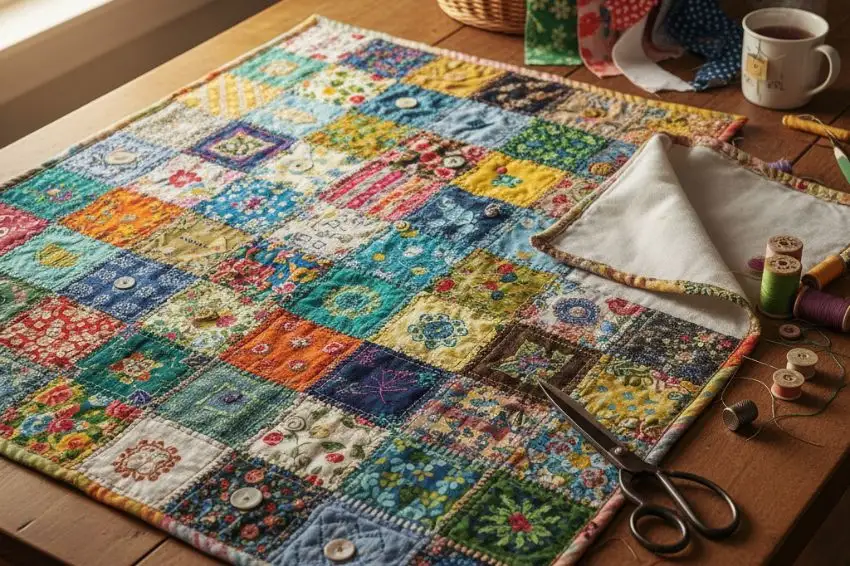
Recycled Materials Crafts: Beyond the Basics
Can recycled materials be safely used for crafts? Absolutely, with some common sense. Clean materials thoroughly, avoid items that contained hazardous substances, and use appropriate sealants when necessary. Recycled glass craft ideas shine here—literally. Smooth glass pieces from broken bottles (tumbled in a rock tumbler for safety) become jewelry, mosaics, or sun catchers.
Newspaper weaving creates surprisingly sturdy baskets and bowls. Roll newspapers into tight tubes, then weave them like you would willow or reed. A coat of non-toxic varnish strengthens the structure. The result looks sophisticated enough that guests never guess it started as yesterday’s headlines.
Plastic-Free Craft Ideas
We’re on a mission to eliminate plastic from our creative spaces. Handwoven jute bags replace plastic totes, canvas and cotton tote bags hand-painted with eco-friendly paints become personalized accessories, and wooden Kathakali and Chenda idols bring cultural artistry into your home without a single synthetic material.
For jewelry makers, upcycled jewelry kits using old buttons, fabric-wrapped beads, and wooden elements create stunning pieces. Each necklace or bracelet carries its own history—buttons from a beloved coat, beads from a broken necklace, wood from a fallen branch.
Natural Materials That Elevate Your Crafts
What natural materials work best for eco crafts? The answer depends on your project, but certain materials consistently deliver beautiful results.
Palm leaf craft items showcase how nature provides ready-made materials. These leaves dry into strong, flexible sheets perfect for weaving baskets, creating wall art, or making decorative bowls. The natural variations in color and texture mean no two pieces ever look identical.
Organic fabric crafts projects feel luxurious against your skin. When you work with organic cotton or hemp, you notice the difference immediately—no chemical smell, no harsh texture. These materials take dye beautifully, whether you’re using sustainable fabric dyeing kits or kitchen ingredients.
Handloom cotton sarees demonstrate what’s possible when traditional techniques meet modern sustainability. These breathable, ethically made fabrics support artisan communities while reducing environmental impact. The craftsmanship is visible in every thread.
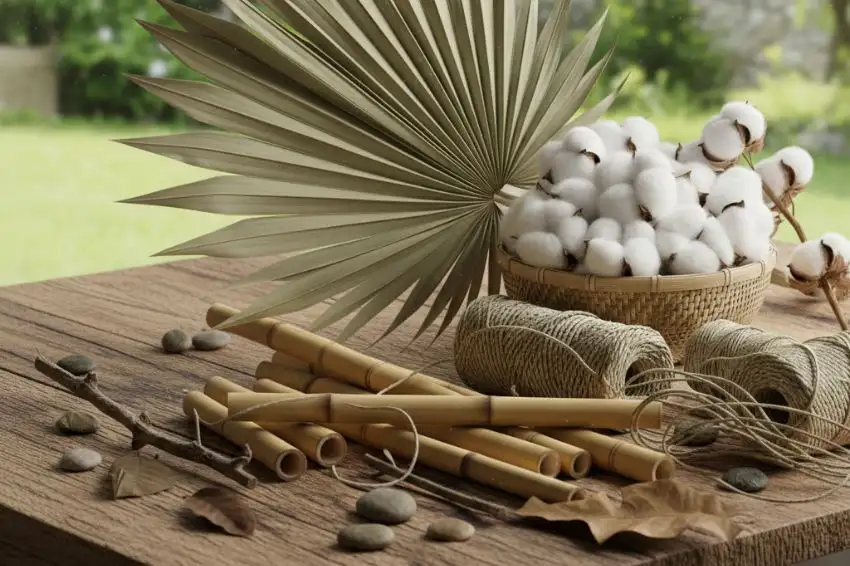
Eco-Friendly Craft Kits: Convenience Meets Consciousness
Are there eco-friendly craft kits available for kids? Yes, and they’re fantastic for all ages. Eco-friendly kids craft kits introduce the next generation to sustainable creativity. These zero waste craft kits include everything needed for a project, with reusable or compostable materials and clear eco craft tutorials step-by-step.
Eco craft subscription boxes take the guesswork out of sourcing materials. Each month brings new projects and supplies, exposing you to techniques and materials you might not discover otherwise. Natural dye kits, for example, might include mordants, instructions, and sample fabrics—everything except the water.
The beauty of eco craft kits lies in their completeness. There’s no excess packaging, no leftover materials you’ll never use, just what you need to create something meaningful. They’re perfect for testing new techniques before committing to bulk supplies.
Building Your Eco-Friendly Craft Practice
Consistency matters more than perfection. Start by replacing one conventional craft supply with a sustainable alternative. Maybe swap out synthetic yarn for natural fiber yarn made from hemp or bamboo. Next month, try biodegradable crafts ideas instead of plastic-heavy projects.
Keep a “materials library” where you collect potential crafting supplies. Designate bins for fabric scraps, clean glass jars, cardboard, and paper. When inspiration strikes, you’ll have resources ready. This system also makes you more aware of what you’re bringing into your home.
Join online communities focused on sustainable crafts. The support and inspiration from fellow crafters keeps your motivation high. Share your projects, ask questions, and learn from others’ experiments. We’re all figuring this out together.
Benefits of Biodegradable Materials in Crafts
What are the benefits of using biodegradable materials in crafts? Beyond the obvious environmental advantages, these materials offer unexpected perks. They’re generally safer for children and pets, with fewer toxic chemicals to worry about. Many natural materials develop beautiful patinas over time, aging gracefully rather than looking worn out.
Biodegradable doesn’t mean fragile. Hemp rope is incredibly strong, bamboo utility products withstand daily use, and properly treated natural materials last for years. You’re not sacrificing quality for sustainability—you’re choosing materials that perform beautifully while returning harmlessly to the earth when their useful life ends.
Working with biodegradable materials connects you to natural cycles. You become more aware of seasons, local plants, and traditional techniques that worked for generations before plastic existed. This knowledge enriches your crafting practice in ways synthetic materials never could.
Starting an Eco-Friendly Craft Business
How can I start an eco-friendly craft business? The market for sustainable products grows daily as consumers seek alternatives to mass-produced goods. Your handmade eco crafts fill a genuine need.
Start small with products you genuinely enjoy making. Authenticity shows in your work, and customers respond to that passion. Whether you’re creating handmade eco-friendly home décor, reusable craft materials, or eco-friendly gift ideas handmade with love, focus on quality over quantity.
| Business Aspect | Sustainable Approach | Benefits |
|---|---|---|
| Sourcing | Local, upcycled, organic materials | Lower costs, unique products, reduced shipping |
| Packaging | Recycled paper, biodegradable materials | Appeals to eco-conscious buyers |
| Marketing | Social media, craft fairs, eco-focused platforms | Reaches target audience effectively |
| Production | Small batches, made-to-order | Reduces waste, maintains quality |
| Pricing | Fair trade principles, living wage | Builds trust, sustainable long-term |
Document your process. Customers love seeing the journey from raw materials to finished product. Show them where your reclaimed wood comes from, how you create natural dyes, or why you chose particular eco-friendly stationery elements. Transparency builds trust and justifies premium pricing.
Partner with like-minded businesses. Stock your products at shops specializing in sustainable goods, collaborate with zero waste stores, or sell through eco-conscious online marketplaces. Your tribe is out there—you just need to find them.
Shopping Smart for Sustainable Craft Supplies Online
Finding sustainable craft supplies online requires a bit of detective work. Look for certifications like GOTS (Global Organic Textile Standard) for fabrics, FSC (Forest Stewardship Council) for wood products, and Fair Trade certifications. These labels aren’t just marketing—they represent verified standards.
Read product descriptions carefully. “Natural” doesn’t automatically mean sustainable, and “eco-friendly” sometimes gets stretched pretty thin by marketing departments. Look for specifics: what percentage is recycled content? Where was it manufactured? What happens to it at end of life?
Support small businesses and artisan cooperatives when possible. Those handwoven jute bags often support rural artisans maintaining traditional crafts. Your purchase sustains more than just your creative hobby—it supports entire communities and cultural traditions.
Seasonal Eco-Crafting Ideas
Nature’s rhythms offer endless inspiration. Spring brings tender leaves perfect for eco-friendly paper crafts and botanical prints. Summer’s bounty includes flowers for pressing, grasses for weaving, and berries for natural dyes. Fall offers seed pods, pine cones, and gorgeous leaves for preservation projects. Winter invites indoor crafting with stored materials and planning for spring’s gardens.
Align your projects with seasons to minimize your environmental footprint. Creating winter decorations from foraged pine cones and branches in December makes more sense than ordering tropical materials online. This approach deepens your connection to your local environment while reducing transportation impacts.
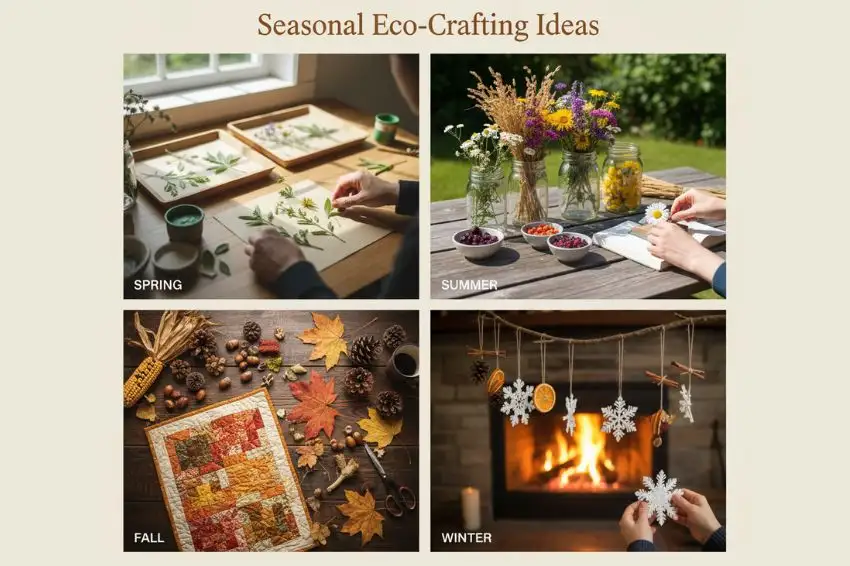
Teaching Kids Sustainable Crafting
Children naturally gravitate toward hands-on creativity. Teaching them eco-friendly practices early establishes lifelong habits. Those eco-friendly kids craft kits make great starting points, but simple household items work beautifully too.
Frame sustainable crafting as treasure hunting. Can they find five things headed for recycling that could become art? Suddenly, they’re looking at the world differently, seeing potential instead of trash. That shift in perspective is perhaps the most valuable lesson you can teach.
Explain the “why” behind choices without overwhelming them. “We use this natural glue because it won’t hurt animals” resonates more than lengthy lectures about microplastics. Keep it age-appropriate and positive, focusing on what they’re accomplishing rather than what they’re avoiding.
Troubleshooting Common Eco-Craft Challenges
Natural materials can be unpredictable. Your natural dye might come out completely different than expected—embrace it. That variation is part of their charm. Keep detailed notes about ratios, timing, and materials so you can replicate successes (or avoid disasters).
Adhesion challenges with eco-friendly glues frustrate many crafters. Some natural adhesives require longer drying times or different application techniques than synthetic options. Patience helps, as does choosing the right adhesive for your specific materials. Rice paste works wonderfully for paper, while plant-based glues handle fabric beautifully.
Durability concerns often come up. Will these natural materials last? With proper care, absolutely. Seal wood projects with natural oils, store fabric crafts away from direct sunlight, and handle delicate items appropriately. Many natural materials actually outlast their synthetic counterparts when treated well.
The Future of Eco-Friendly Crafting
Innovation in sustainable materials accelerates constantly. We’re seeing mushroom leather, algae-based yarns, and bioplastics made from agricultural waste. These materials might sound futuristic, but they’re available now, pushing eco-friendly crafts into exciting new territory.
The community around sustainable crafting grows stronger each year. More tutorials, better supply chains, increased awareness—all these factors make green crafting easier and more accessible. What seemed niche a decade ago is becoming mainstream, and that shift benefits everyone.
Your role in this movement matters more than you might think. Every project you complete, every material you choose to upcycle, every person you inspire contributes to larger change. We’re not just crafting objects; we’re crafting a different relationship with our planet and our resources.
Conclusion: Your Creative Journey Starts Here
Eco-friendly crafts aren’t about perfection or purity—they’re about conscious choices and creative joy. You don’t need to overhaul your entire craft room overnight or guilt yourself over past projects. Start where you are, use what you have, and make one sustainable choice at a time.
The beauty of sustainable crafts lies in their accessibility. Whether you’re working with recycled paper kits, organic cotton fabric, bamboo utility products, or materials foraged from your own backyard, you’re participating in something meaningful. Your creativity has purpose beyond aesthetics—it demonstrates that beautiful, functional items don’t require environmental compromise.
So grab that glass jar you were about to recycle, those fabric scraps gathering dust, or that natural dye kit you’ve been curious about. Your eco-friendly crafting adventure awaits. The planet doesn’t need perfect crafters; it needs people who try, experiment, and keep showing up with their creativity and conscience intertwined.
What will you create today that honors both your artistic spirit and our shared home? The possibilities are as endless as your imagination—and significantly kinder to the world we all inhabit.
Ready to transform your crafting practice? Start with one sustainable swap this week and share your creation with our community. Together, we’re crafting a greener future, one beautiful project at a time.

